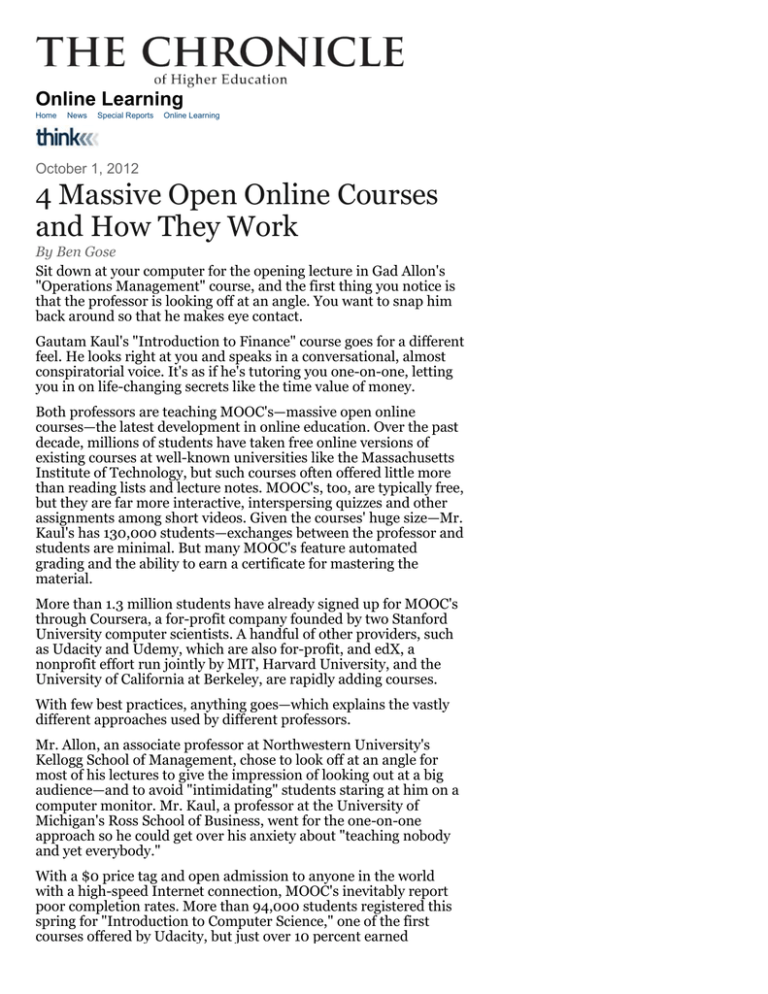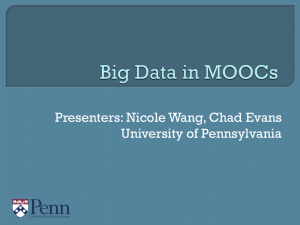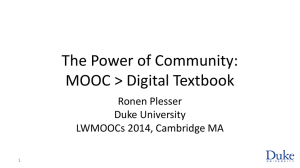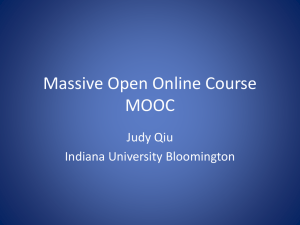
Online Learning
Home
News
Special Reports
Online Learning
October 1, 2012
4 Massive Open Online Courses
and How They Work
By Ben Gose
Sit down at your computer for the opening lecture in Gad Allon's
"Operations Management" course, and the first thing you notice is
that the professor is looking off at an angle. You want to snap him
back around so that he makes eye contact.
Gautam Kaul's "Introduction to Finance" course goes for a different
feel. He looks right at you and speaks in a conversational, almost
conspiratorial voice. It's as if he's tutoring you one-on-one, letting
you in on life-changing secrets like the time value of money.
Both professors are teaching MOOC's—massive open online
courses—the latest development in online education. Over the past
decade, millions of students have taken free online versions of
existing courses at well-known universities like the Massachusetts
Institute of Technology, but such courses often offered little more
than reading lists and lecture notes. MOOC's, too, are typically free,
but they are far more interactive, interspersing quizzes and other
assignments among short videos. Given the courses' huge size—Mr.
Kaul's has 130,000 students—exchanges between the professor and
students are minimal. But many MOOC's feature automated
grading and the ability to earn a certificate for mastering the
material.
More than 1.3 million students have already signed up for MOOC's
through Coursera, a for-profit company founded by two Stanford
University computer scientists. A handful of other providers, such
as Udacity and Udemy, which are also for-profit, and edX, a
nonprofit effort run jointly by MIT, Harvard University, and the
University of California at Berkeley, are rapidly adding courses.
With few best practices, anything goes—which explains the vastly
different approaches used by different professors.
Mr. Allon, an associate professor at Northwestern University's
Kellogg School of Management, chose to look off at an angle for
most of his lectures to give the impression of looking out at a big
audience—and to avoid "intimidating" students staring at him on a
computer monitor. Mr. Kaul, a professor at the University of
Michigan's Ross School of Business, went for the one-on-one
approach so he could get over his anxiety about "teaching nobody
and yet everybody."
With a $0 price tag and open admission to anyone in the world
with a high-speed Internet connection, MOOC's inevitably report
poor completion rates. More than 94,000 students registered this
spring for "Introduction to Computer Science," one of the first
courses offered by Udacity, but just over 10 percent earned
certificates for completing the class. Most didn't get through the
first lecture.
"If you were in a classroom and 90 percent of the students were
walking out in the first few minutes," concedes David Evans, a
University of Virginia computer scientist who taught the course,
"that would be pretty depressing."
On the other hand, how many professors can boast of shepherding
nearly 10,000 students through a challenging course in just one
semester?
Following are reports on how the new frontier is playing out at
four of the largest free MOOC's.
'Introduction to Finance,' Coursera
Gautam Kaul, professor of finance, University of Michigan's Ross
School of Business
Amanda L. Smith, Avery Photo
Joe Alfonso, a financial adviser from Oregon, is taking the online
finance course as a "refresher."
oe Alfonso, a financial planner in a suburb of Portland, Ore.,
stumbled upon Mr. Kaul's class after his wife read a newspaper
article about Coursera. Mr. Alfonso wanted a "refresher" with
a more academic focus than in previous courses he had taken to
earn a financial-planning credential. He especially likes the way the
professor weaves his own philosophy into the lectures.
J
Mr. Kaul decided early on not to interact with students—he feared
doing so would consume all his time. Yet Mr. Alfonso says he
almost feels closer to Mr. Kaul than he did to his own professors at
Cornell University, where he earned a philosophy degree in 1981
(and spent much of time interacting with teaching assistants).
"In a weird way, you have this connection with him," Mr. Alfonso
says. "You almost feel like he's speaking directly to you."
Mr. Kaul began designing the course as soon as the spring semester
ended, forgoing his usual summer focus on administrative tasks
and research. He receives no compensation from Coursera.
Michigan is paying him for the work, but only because he's among a
chosen group at the university experimenting with the new format.
His lecture segments run longer than average for the genre—as long
as 20 minutes. "You don't want to break up something that can't be
broken up," he insists.
Creating tests for the end of each segment that are challenging but
not too hard has been "mind-bogglingly complex," he says. "The
learning curve is extremely steep."
Mr. Alfonso says he fits the coursework in between meetings with
clients. While he needs continuing-education credits to maintain
his professional certification, he's not taking the course for that
reason.
"I'm doing it because it's great stuff," Mr. Alfonso says. "I would
have dropped it if it wasn't."
***
'Circuits and Electronics,' MITx
Anant Agarwal, president of edX and a former directorof MIT's
Computer Science and Artificial Intelligence Laboratory
Lance Murphey for The Chronicle
Frank Basile, an aircraft technician, took an MITx course on circuits
and electronics to increase his knowledge.
rank Basile works the night shift at FedEx, helping to
maintain the cargo planes at the company's hub, in Memphis.
Last spring, on nights when the flights were going smoothly,
he and a co-worker plowed through segments of "Circuits and
Electronics."
F
Mr. Basile had experimented with open courseware at MIT but had
never completed any courses. "It just didn't have a structured feel,"
he says. Mr. Agarwal's course was different—with lab experiments,
deadlines for homework, and a midterm and final. "It was just like
taking a real class," Mr. Basile says.
He learned about circuits in the military. At work he uses circuits
that control functions like aviation warning systems. But the MITx
course (now part of edX) required knowledge of advanced math,
including differential equations. So Mr. Basile, who doesn't have a
college degree, found himself turning to Khan Academy, which
offers more than 3,000 instructional videos on YouTube. Mr.
Agarwal had warned in his course description that his class
wouldn't be "MIT-lite."
"I had to put everything I had into it in order to pass," says Mr.
Basile, who earned a certificate for doing so. "I certainly got the
sense that they didn't hold anything back."
Despite the difficult subject matter, Mr. Agarwal set out to make
the course fun. He talks about the "gamification" of learning. A
generation reared on video games needs interactive stimulation to
stay engaged, he believes.
The professor built an online "circuits sandbox" that has the feel of
manipulating circuitry on a laboratory table. Students make
adjustments in order to get it to play music.
The discussion forums also had a game-related component—
students earned "karma points" for providing answers that others
liked. The biggest point earners eventually earned "instructor
privileges," which allowed them to do things like end discussion
threads.
"We're babes in the woods with these massive online courses," Mr.
Agarwal says. "We're learning so much every day."
Mr. Basile liked the innovations, but he also sought a hands-on
experience. He ordered resistors and capacitors so he could build
the kind of circuits discussed in the course.
"Once you do it in real life," he says, "you get a better sense of how
circuits really work."
***
'Operations Management,' Udemy
Gad Allon, associate professor of managerial economics and
decision sciences, Northwestern University's Kellogg School of
Management
Patrick Murphy-Racey for The Chronicle
Krissa Swain, of Knoxville, Tenn., is taking "Operations
Management" online to help develop her management skills.
rissa Swain is just a dissertation away from earning a Ph.D.
in history at Cornell. But when her employer, the online
tutoring company Smarthinking, promoted her to a
management position a year ago, she knew it was time to go back to
school.
K
She recently enrolled in "Operations Management," which focuses
on managing a business to produce goods and services. "I work
with a lot of operations people," she says. "In order to be able to
speak their language, I thought it would be helpful for me to take
the course."
Udemy approached Mr. Allon about teaching the course, and
Northwestern, which hasn't aligned with any MOOC providers,
encouraged him to try it.
The version of the course that he teaches to Kellogg students relies
heavily on case studies and classroom discussion—both of which
presented problems as he designed the MOOC. A casebook for an
M.B.A. course typically costs $40 to $50, he says, an amount that
might discourage some people from even considering the class. He
decided to proceed in Coursera without one. And while online
discussion forums can be fine for resolving problems, they're not
always great at stimulating the freewheeling discussion that Mr.
Allon encourages in his live class.
The MOOC has more than 4,400 students, but the discussion board
has been a disappointment, he concedes. Most threads consist of
little more than a posted question that he has answered.
"This is a learning experience for me as much as for my students,"
Mr. Allon says.
He is proud of the production quality of the video lectures, even if it
took him a while to find his rhythm. "It's very difficult to teach
when you don't have a crowd in front of you," he says. He scaled
back the video segments to five minutes apiece after finding that
longer segments led students to drift away.
Ms. Swain, who works from her home office in Knoxville, Tenn.,
spends the first 45 minutes of each workday on the class. "My
company considers it part of my professional development," she
says. "They encourage it."
***
'Introduction to Computer Science,' Udacity
David Evans, associate professor of computer science, University
of Virginia
Nathan G for The Chronicle
Rajeev Bajpai, an airline pilot based in Mumbai, took an online
computer-science course to gain programming skills.
ajeev Bajpai, an airline pilot based in Mumbai, was poking
around on Stanford's Web site last winter when he spied a
link to the computer-science class taught by Mr. Evans.
R
Mr. Bajpai, who also has a management role at his airline, was
interested in computers and thought some programming expertise
would help him at work.
"There are many small jobs that lend themselves to automation and
analysis," he says. "I have engineering graduates reporting to me.
When they write the code, I'll know how to walk the talk."
Mr. Evans knew he would need to find a way to hook the MOOC
students early and keep them coming back. So he structured the
course around a fun activity—building a search engine. The sevenweek course included about 90 minutes of lectures each week, but
Mr. Evans divided his time on camera into segments as short as two
minutes. He also tried to keep students engaged with plenty of
quizzes and programming exercises.
The course uses Python, a programming language in applications
designed by Google and NASA, among others. Mr. Evans thinks the
course can be offered again and again, with tweaks, for several
years. When the first run ended, last spring, he changed some
homework problems that had confused students and added a unit
that would help them transition into higher-level courses. Students
can now take a version of the course that allows them to spend as
long as they like working through the material.
"One of the nice things about the online format is that you can
improve parts of the class and reuse the rest," Mr. Evans says. "The
core ideas in computing don't change."
Mr. Bajpai had to drop out of the winter version of the course
because of family and work obligations. "I unenrolled, thinking that
was the etiquette," he says. But he learned recently that he could
pick up where he left off, and this time he expects to complete the
course.
"I'm just happy to be here," he says. "It was an impossible dream
only a handful of years ago."
Comments
Powered by DISQUS
Add a comment
Log in to post
with your Chronicle account:
Don't have an account? Create one now.
Or log in using one of these alternatives:
Showing 3 comments
Sort by
Oldest first
Follow comments:
by e-mail
by RSS
Real-time updating is paused. (Resume)
stevekayser 1 day ago
Excellent article ben. Thanks for sharing. You're right. Anything goes right now - sorta like the wild
wild west. There will be stops and starts - but this is really going to help increase access and
affordability -- while helping reduce student loan debt.
Like
stevekayser 1 day ago
Question - why don't you guys have social media sharing capabilities here? I'll share this on Twitter
- but it'd be nice if the sharing functionality would be available at the top/bottom of the article. (I'm
a geek)
Like
stevendkrause 1 day ago
Here's one of the things I find striking about these examples: they are all "non-traditional" adult
learners who seem most interested in the joys of "learning for learning's sake." Three out of four of
these folks (I assume the pilot is in this camp) have college degrees and one is ABD.
I'm glad these folks are getting something out of this. But I have yet to read a story anywhere
profiling the kinds of students that Coursera et al say they are seeking: more or less traditional
college-aged students who are looking for an alternative (or supplement to) the traditional
classroom experience. In other words, where are the actual "students" in these classes?
Again, I'm all for "life learners" sitting in on free classes. But that isn't really a business model, is it?
5 people liked this.
Like
Copyright 2012. All rights reserved.
The Chronicle of Higher Education 1255 Twenty-Third St, N.W. Washington, D.C. 20037



